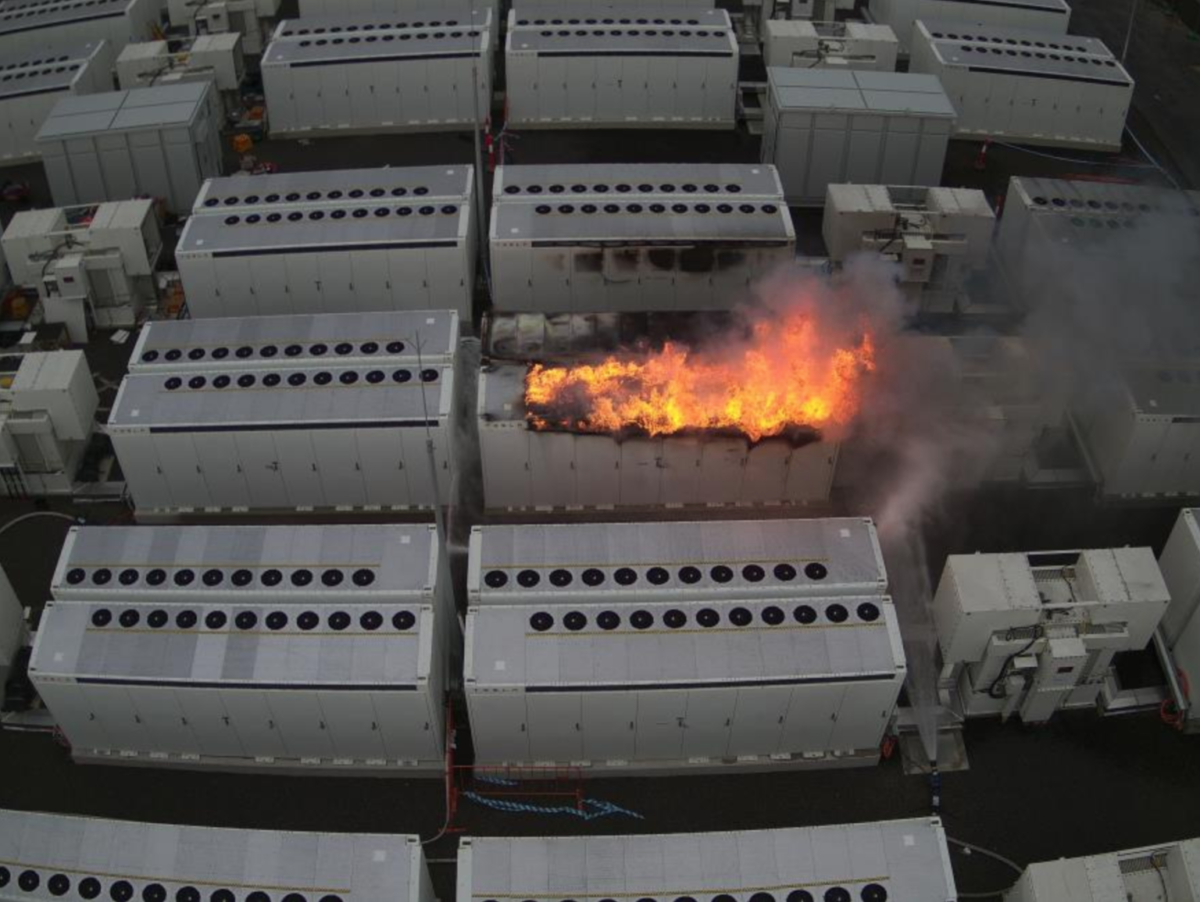On Friday, two days after Neoen posted the Tweet below, a Tesla Megapack caught fire at the site of the Victorian Big Battery during testing of the Neoen-developed 300 MW/450 MWh project, which is due for completion this year.
Thrilled to announce Victorian Big Battery is now registered with the Australian Energy Market Operator – just over 200 days since the start of construction ! Thanks to everyone involved ! @AEMO_Media @VicGovAU @LilyDAmbrosioMP @Tesla @AusNetServices @downergroup @UGLPtyLimited pic.twitter.com/OD67kUbjF2
— Neoen Australia (@NEOEN_AU) July 28, 2021
Fire and Rescue Victoria led the response to the blaze, which is believed to have originated in one Megapack module and to have affected another on the site.
More than 30 fire trucks and support vehicles responded to the incident, which was contained by firefighters wearing breathing apparatus, before it could spread to others of the 210 battery-energy storage modules on site in Moorabool in the City of Greater Geelong.
A scientific officer monitored air quality with the assistance of drones, and although a Watch & Act Warning was issued after midday, for toxic smoke at Batesford, Bell Post Hill, Lovely Banks and Moorabool residents, Victoria’s Environment Protection Authority found that air quality in the local area remained good.
Neoen Australia’s Managing Director, Louis de Sambucy said in a statement on Friday afternoon that, “No one was injured and the site has been evacuated. Neoen and Tesla are working closely with emergency services on site to manage the situation”.
The Australian Energy Market Operator (AEMO) confirmed that the battery had been separated from the grid and the fire had not affected operation of electricity services.
The Country Fire Association (CFA) remained on site with FRV after the incident and continued to “monitor the temperature decline of the two affected battery packs”.
An update from the CFA yesterday afternoon (Sunday 1 August), reported, “The fire has subsided significantly. Crews are now doing atmospheric monitoring around the cabinet and will check to see how active the fire is internally behind each of the doors.”
Determining the cause of the blaze is key
The incident will rekindle concerns that lithium-ion batteries are prone to catching fire, but the cause of the fire is as yet unknown and all parties to the development of the battery facility will be engaged in determining its origins and subsequent appropriate action.
The Victorian Big Battery is set to become one of the largest such storage facilities in the world, and the biggest to be completed so far in Australia.
It will provide a critical boost to the security of Victoria’s energy supply while supporting greater penetration of renewables into the grid.
In November, AEMO awarded the battery a 10-year contract under the System Integrity Protection Scheme, which will require the operators to reserve 250 MW of its capacity to participate in increasing the capability of the Victoria-to-New South Wales Interconnector (VNI) and respond to unexpected network outages.
And in February this year, developer Neoen reached financial close on the battery after the Australian Government’s Clean Energy Finance Corporation (CEFC) provided a $160 million debt facility to finance design, construction and operation of the project.
Tesla’s Megapack technology is also being deployed in Transgrid’s $61.9 million 50 MW/75MWh, Wallgrove Grid Battery in Western Sydney, and in a number of smaller projects.
Batteries expected to stabilize a grid based on renewables
The Australian Renewable Energy Agency has contributed $11.5 million in funding for Wallgrove which should reach completion this year, and which is intended to provide technical experience of how often the battery is needed to contribute fast frequency response to the NSW network, and how much electricity it is able to store and dispatch under various conditions.
Batteries have emerged as a more cost-effective alternative to controlling frequency than other technologies such as synchronous condensers, and are expected to thereby reduce the ultimate cost of electricity to consumers.
Australia’s power systems currently rely on inertia provided by the large turbines at the heart of coal, gas and hydro generators to maintain a consistent frequency and help the system ride out any disturbances. As more sources of wind and solar generation are connected to the grid and coal-fired generators are retired, alternative sources of inertia will be needed to stabilize the network.
ARENA CEO Darren Miller, has said that “Large-scale batteries have a big role to play in firming and balancing our electricity system as we move towards a future energy mix.”
An easily deployable, smaller footprint technology
Tesla announced the arrival of its Megapack product in July 2019, as a rapid-deployment, large-scale energy-storage solution.
Supplied fully assembled, Megapack’s modular construction enables the company to install “an emissions free, 250 MW/1 GWh power plant in less than three months” or four times faster than a fossil fuel plant of the same size, the company said at the time.
The Megapack offers a 60% increase in energy density over its Powerpack utility-scale storage systems which were famously installed at the then 100 MW/129 MWh Hornsdale Power Reserve in South Australia in December 2017.
Following its hugely successful deployment, the Hornsdale Power Reserve was expanded to 150 MW/194 MWh in September 2020.
De Sambucy has said, “We will provide updates and further details,” of the fire and its cause, “as they become available.”
This content is protected by copyright and may not be reused. If you want to cooperate with us and would like to reuse some of our content, please contact: editors@pv-magazine.com.




Has the cause and any remedial action been published